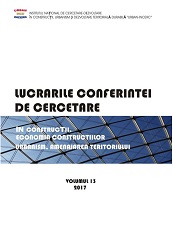Sinergia rezilienţei seismice a clădirilor şi dezvoltării durabile. Învaţăminte de la cea de a 16-a conferinţă mondială de inginerie seismică, Chile, 2017
Synergy of the seismic resilience of buildings and sustainability. Lessons learnt at the 16th world seismic engineering in Chile, 2017
Author(s): Emil-Sever Georgescu
Subject(s): Architecture
Published by: INCD URBAN-INCERC
Keywords: seismic resilience; sustainability; seismic performance; Chile; Romania
Summary/Abstract: The paper deals with the possibility to correlate the requirements of resilience and sustainable development in an efficient way in seismic zones. Sustainable development of constructions and infrastructures, as a background of social-economic life, is apparently a very demanding requirement in seismic zones, as much as the existing built stock is vulnerable and frequently exposed to considerable damage and loss. Thus, seismic risk becomes a unsustainable burden for present and future generations. Romania is in such a situation caused by the vulnerability of a large numer of buildings, proved by the Vrancea 1940 and 1977 earthquakes, events with long-term impact on its development. In contrast with this statement, although Chile repeatedly suffered the impact of destructive earthquakes, is a positive example for Romania, since earthquake engineering design codes are applied, ensuring a favorable behavior for new generations of buildings, and these are based on advanced technologies.The specific requirements of the discussed approaches (resilience and sustainable development) will be analyzed in relationship with effects of destructive earthquakes in both countries, with case studies of three buildings of last generation in Santiago de Chile. These are seismically resilient, as they incorporate a central core with shear-walls, with a well defined role in drift control, while in two cases deformations are controlled by special dissipative devices that are essential for seismic resilience. Specific data obtained at the 16-th World Conference on Earthquake Engineering, January 9-13, 2017, Santiago, Chile will be analyzed in this respect.In both countries, earthquake disasters of 1940’s pushed the drafting and enforcement of seismic design codes and shear-walls structures have been preferred versus framed ones. Earthquakes of 1960 in Chile and 1977 in Romania confirmed the overall efficacy of codes, as well as some vulnerability of structural types and the need of local seismological data, as a background of risk reduction. The Mw 8.8 Maule-Chile earthquake of February 27, 2010 and Mw 8,3 Illapel of September 16, 2015 proved the adopted approaches. There is a remarkable efficient cooperation between architects, urban planners and engineers in Chile, as they work to integrate approach of seismic resilience with that of ecological-energy design, energy and environment performance with other policies and requirements, to reduce pollution and ensure traffic flows, all based on sustainability criteria.The experience of last decades has shown that traditional types of structures cannot provide a predictable resilience and it is necessary a qualitative change, using new technological systems for seismic performance control. At the same time, the global and European Union sustainable development requirements impose new constraints, whose simultaneous achievment is debatable. The Chile example proves that the synergy of these requirements is possible, given the level attained in high-rise buildings engineering, utilization of performant earthquake response control, that are feasible even in case of current urban structures (ca. 20 stories), with glass facades, all being of interest for Romania too.
- Page Range: 34-40
- Page Count: 8
- Publication Year: 2017
- Language: Romanian
- Content File-PDF

